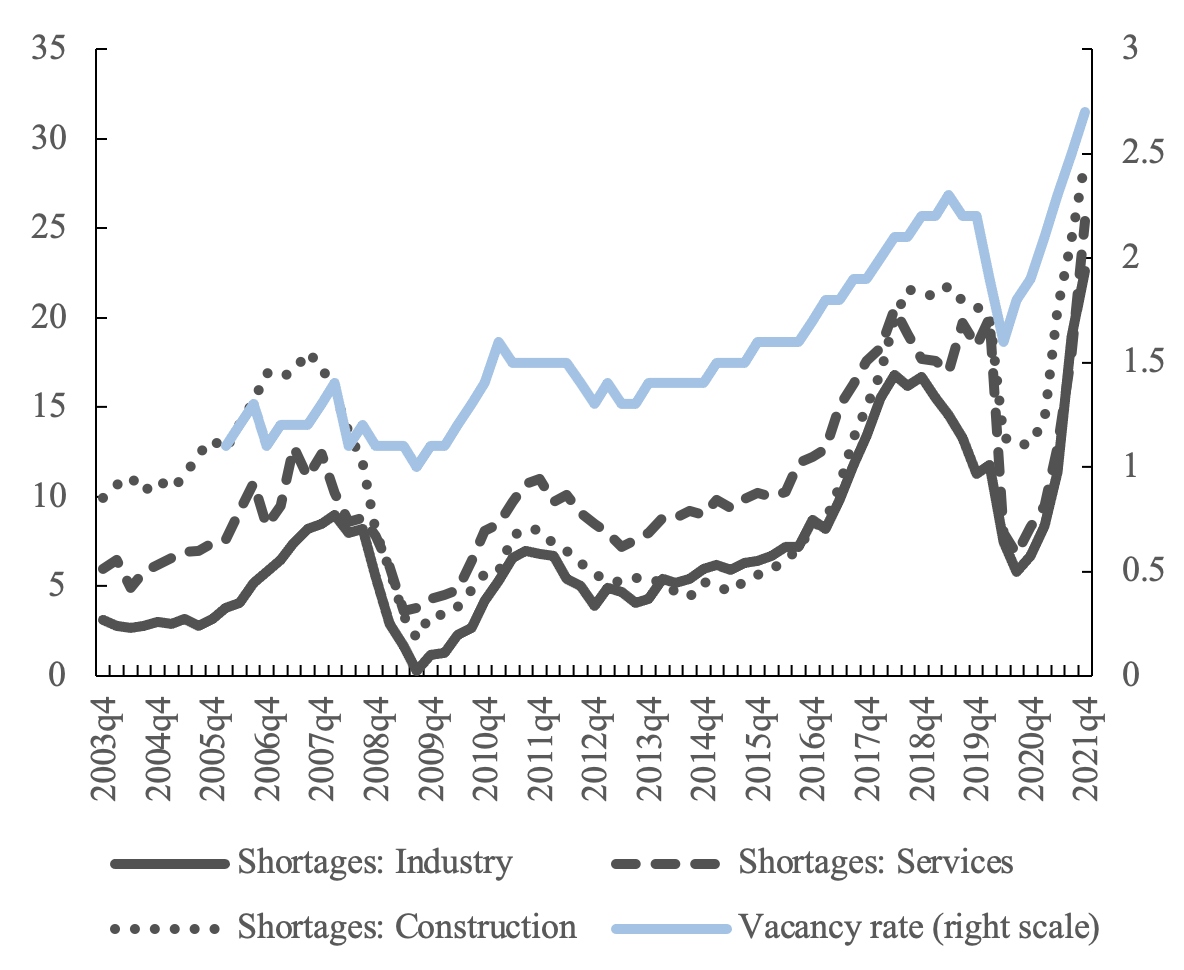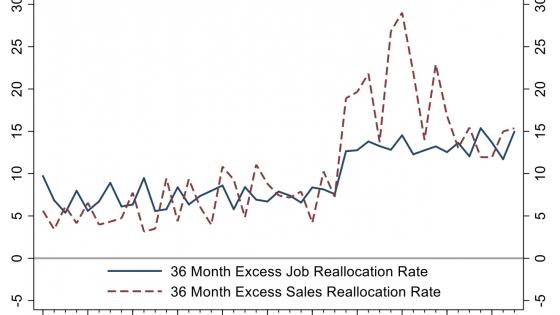After the outbreak of COVID-19, concerns were raised over a possible increase in labour market mismatch associated with large-scale sectoral reallocation needs (Anayi et al. 2021). These risks appear not to have materialised. Recent evidence shows that indicators of labour market mismatch in advanced economies worsened after the COVID-19 outbreak but started improving in 2021. Moreover, their contribution to the employment shortfall was rather limited (Duval et al. 2022).
In recent work (Kiss et al. 2022), we assess the growing tightness of euro area labour markets since mid-2021 through the lens of the Beveridge curve, and conclude that the uptick in labour market mismatch in the aftermath of COVID-19 has been rather mild and largely a temporary phenomenon.
Compared with previous recessions, the one associated with COVID-19 has had a relatively limited impact on employment across the euro area. Mainly in light of the extensive policy support and the implementation of short-time work (STW) schemes, the COVID-19 shock affected hours worked much more than employment (European Commission 2021, Giupponi et al. 2022).
As was the case in previous recessions, the outbreak of the pandemic was followed by a sudden fall in job vacancies in the euro area, but in this case the recovery was particularly fast and steep (Figure 1). By the end of 2021, labour shortages reported in the EU business and consumer survey were above those recorded before the pandemic. The euro area vacancy rate exhibits a similar pattern. In 2020, shortages fell most in services and less so in industry and construction, while in 2021 shortages increased faster in services, reflecting the fact that services are more contact-intensive.
Figure 1 Labour shortages and vacancy rate, euro area
Notes: The labour shortage indicators reflect the shares of firms reporting labour is a factor limiting their production. The vacancy rate is defined as the ratio of vacant posts to all posts (occupied and vacant), covering industry, construction and services (sectors B to S).
Source: EU business and consumer survey and Eurostat.
Dynamics along the euro area Beveridge curve (Figure 2) indicate that while vacancies – proxied by the survey-based labour market shortage indicator – dropped immediately after the COVID-19 outbreak, unemployment increased with some lags and its movements followed the stringency of containment measures.
Over the pandemic period (blue dots in Figure 2), the counter-clockwise loop in the vacancy-unemployment space which typically follows negative labour demand shocks was characterised by a moderate oscillation in unemployment and a sharp fluctuation in vacancies. This contrasts with the developments after the financial crisis (green dots), where movements in unemployment were much larger, while movements in vacancies were more muted.
Figure 2 The Beveridge curve for the euro area, 2005-2021
Notes: Vacancies are proxied by the indicator of labour shortages is defined as the share of firms reporting that labour is a factor limiting production. This is computed as a weighted average (based on value-added weights) of sectoral indicators on manufacturing, services and construction.
Source: EU business and consumer survey and EU Labour Force Survey (Eurostat)
Upward shifts in the Beveridge curve signal a possible deterioration in labour market matching, as more unemployment is observed for a given number of vacancies. Figure 2 shows that while after the financial crisis there was a clear upward shift in the Beveridge curve, a simple inspection of the data is not sufficient to conclude that the Beveridge curve has shifted upwards after COVID-19.
To identify possible shifts in Beveridge curves on the basis of a larger sample, we estimate econometrically the Beveridge curve relation across a panel of euro area countries over the period 2003Q3-2021Q3.
Compared with past work in this vein, our analysis explicitly accounts for residual autocorrelation, and estimates regression parameters using the Prais-Winsten feasible GLS estimator (FGLS), besides OLS, to address the induced bias.
The Beveridge curve specification has the unemployment rate as the dependent variable. Explanatory variables include the labour shortage indicator and its square (to capture the convexity of the Beveridge curve relation) plus country and time effects. In addition to this basic specification, two indicators of mismatch – one measuring skill mismatch, one mismatch across industries – are included.
Both mismatch indicators are depicted in Figure 3. While the skills mismatch indicator increased somewhat over the pandemic, this increase was minor compared with the major and protracted rise after the 2008 financial crisis. The sectoral dispersion of labour shortages increased more significantly over the pandemic, to a degree comparable to the recession of 2009, but fell again to historically average levels over 2021.
Figure 3 Skills mismatch indicator and dispersion of sectoral shortages, euro area
Notes: The skills mismatch indicator is defined as the relative dispersion of employment rates by qualification level. The dispersion of sectoral shortages is defined as the coefficient of variation of labour shortages in, respectively: industry, construction, and services.
Source: EU business and consumer survey and EU Labour Force Survey (Eurostat).
Tracking over time the estimated Beveridge curve time effects allows us to capture joint shifts in Beveridge curves across the euro area, thus signalling a possible worsening of matching conditions on top of what is already captured by the skill and sectoral mismatch indicators. Time effects in the aftermath of the COVID outbreak show a relatively modest increase, suggesting that most of the increase in unemployment can be explained by the estimated Beveridge curve, and in particular by the fall in vacancies (Figure 4).
Moreover, time effects exhibit a downward trajectory in 2021. By the third quarter of 2021, the time effects are close to historical lows seen in 2008, suggesting that the EU Beveridge curves post COVID-19 do not reveal a high degree of mismatch by historical standards.
Figure 4 Joint movements of euro area Beveridge curves: Estimated time effects
Note: Quarterly time effects from the joint estimation of Beveridge curves across the EU.
Source: Authors’ calculations.
Overall, the evidence suggests that growing structural mismatch is not the main reason underpinning growing labour market shortages after the COVID crisis. Part of these shortages may therefore be temporary and linked to the very sudden increase in labour demand after the removal of containment measures in a context where the labour force was less reactive than usual.
Labour shortages may also have been affected by demography, namely, the trend reduction in working-age populations across the euro area due to ageing and dampened mobility and migration over the pandemic.
However, growing mismatches cannot be ruled out going forward (e.g. Carrillo Tudela et al. 2022). COVID-19 may have compounded structural trends that carry risks for labour market matching, including the growing relative demand for teleworkable occupations and non-routine tasks, and for skills used intensively in low-emission activities (European Commission 2021). The risk of a structural increase in labour shortages has also been associated with the widespread use of STW schemes, on the ground that these arrangements hamper transitions to expanding activities. These concerns are probably overstated, since by January 2021 the jobs supported by STW schemes in the euro area had fallen to 1.5% after climbing to about 20% in April 2020.
Should labour market shortages persist amid stronger evidence of growing mismatch, there would be a role for policy to support the activation of groups facing barriers to work, as well as supporting labour market reallocation, including by fostering investment in skills in short supply and by strengthening public employment services in such a way to ease labour market matching.
References
Anayi, L, J M Barrero, N Bloom, P Bunn, S Davis, J Leather, B Meyer, M Oikonomou, E Mihaylov, P Mizen and G Thwaites (2021), “Labour market reallocation in the wake of Covid-19”, VoxEU.org, 13 August.
Arpaia, A, A Kiss and A Turrini (2014), “Is unemployment structural or cyclical? Main features of job matching in the EU after the crisis”, IZA Policy Paper No. 91.
Bonthuis, B, V Jarvis, and J Vanhala (2013), “Shifts in euro area Beveridge curves and their determinants”, IZA Journal of Labor Policy 5: 20.
Börsch-Supan, A H (1991), “Panel data analysis of the Beveridge Curve: Is there a macroeconomic relation between the rate of unemployment and the vacancy rate?”, Economica 58(231): 279-297.
Bova, E, J Tovar Jalles and C Kolerus (2018), “Shifting the Beveridge curve: What affects labour market matching?”, International Labour Review 157(2).
Carrillo-Tudela, C, A Comunello, A Clymo, A Jäckle, L Visschers and D Zentler-Munro (2022), “Job search and mismatch during the Covid-19 pandemic”, VoxEU.org, 07 April.
Consolo, A and A Dias da Silva (2019), “The euro area labour market through the lens of the Beveridge curve”, ECB Economic Bulletin 2019(4): 66-86.
Duval, R, Y Ji, L Li, M Oikonomou, C Pizzinelli, I Shibata, A Sozzi and M M Tavares (2022), “Labor Market Tightness in Advanced Economies”, Staff Discussion Notes No. 2022/001.
Ebeke C and G Everaert (2014), “Unemployment and Structural Unemployment in the Baltics”, IMF Working Paper 14/153.
ECB (2022), Economic Bulletin, Issue 2 / 2022.
European Commission (2013), “Labour market developments in Europe 2013”, Directorate-General for Economic and Financial Affairs.
European Commission (2021), “Labour market and wage developments in Europe: Annual Review 2021”, Directorate-General for Employment, Social Affairs, and Inclusion.
Giupponi, G, C Landais and A Lapeyre (2022), “Should we insure workers or jobs during recessions?”, Journal of Economic Perspectives 36(2): 29-54.
Groenewold, N (2003), “Long-run shifts of the Beveridge Curve and the frictional unemployment rate in Australia”, Australian Journal of Labour Economics 6(1): 65–82.
Kiss, A, A Turrini and A Vandeplas (2022), “Slack vs. tightness in euro area labour markets: growing mismatch after COVID-19?”, Quarterly Review of the Euro Area 21(2), European Commission, Directorate-General for Economic and Financial Affairs.
Kiss, A and A Vandeplas (2015),” Measuring skills mismatch”, Analytical Web Note 7/2015, Directorate-General for Employment, Social Affairs and Inclusion.
Valletta, R G (2005), “Why Has the U.S. Beveridge Curve Shifted Back? New Evidence Using Regional Data”, Federal Reserve Bank of San Francisco Working Paper 2005-25.
Wall, H J and G Zoega (2002), “The British Beveridge curve: A tale of ten regions”, Oxford Bulletin of Economics and Statistics 64(3): 257-276.










